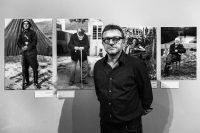
Image: Gustavo Germano. Photo: Marcelo Aurelio.
Q&A with Gustavo Germano
5.2.21
Argentinian photojournalist and graphic media editor Gustavo Germano began his practice in 1986 whilst traveling around Latin America. He tells us about his PHOTO 2021 work Ausencias (Absences)—a powerful series about the victims of enforced disappearance of the Latin American dictatorships.
Hello Gustavo, please start by telling us something about yourself that is not in your bio.
I was a “viajante” (travelling salesman) of school books for two years in Patagonia. The southernmost point I reached was the city of Ushuaia. I was 20 years old.
What will you be exhibiting at PHOTO 2021?
It will be a small presentation of three diptychs from three series of Ausencias (Absences):
– Argentina carried out in 2006 on victims of the illegal repression of the dictatorship from 1976 to 1983
– Brazil held in 2012 on victims of the dictatorship from 1964 to 1985.
– Uruguay from 2016 on the dictatorship from 1973 to 1984.
The work will be presented on billboards outside The SUBSTATION.
What inspired this project?
The idea is that it would be possible to understand (not explain) the devastating effect that disappearances had on the people around them, in addition to what was done to the victim themselves. The permanent presence of absence, a common phrase in my mother’s home, is perhaps the clearest way to explain it.
![Image: Gustavo Germano, detail from the series [Auscenias (Absences)].](https://photo.org.au/api/wp-content/uploads/2020/03/Ausencias_GustavoGermano_05-200x149.jpg)
Image: Gustavo Germano, detail from the series Auscenias (Absences).
How does it relate to the theme of FOTO 2021: "The Truth"?
Concealing the truth is a constitutive fact of forced disappearance. As the poet Juan Gelman said, “The word disappeared is tricky because it hides four processes: illegal detention, torture, murder, and concealment of the body.” All this is denied and hidden.
Can you tell us about the process to make this work?
As a process, it is long and requires many “complicities”. A small team in the field works on the investigation and recovery of photographs with the relatives and with those linked to the disappeared. By the time the photographs are taken, we have already had many months of contacts and coordination both in the selection of the images and in the logistics to create the image. Finally something very powerful connects me with the protagonists after having shared that moment of high emotional tension. Many of them had not returned to those places in 30 years. A statement is made with their presence and a space that should be occupied by a loved one.
What do you hope the public will get out of your work?
I would like people to feel emotion and empathy.
If your work on PHOTO 2021 were a song, what would it be?
It would definitely be ‘Desapariciones’ (‘Disappearances ‘) Rubén Blades. It is an iconic song in Latin America.
What other artists or exhibitions are you looking forward to seeing at PHOTO 2021?
How difficult! Although I will not be able to travel, there are many that I would like to see. I would certainly like to see the works of George Georgiou and Michael Cook.
And finally, what advice would you give your 15-year-old self?
I have twins who are 15 years old at the moment, so I can tell my 15-year-old self the same thing I tell them; study hard and get to know the world soon! Ha ha.